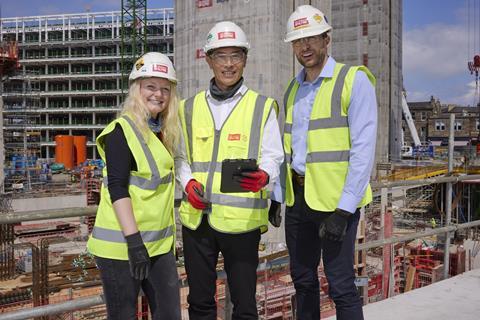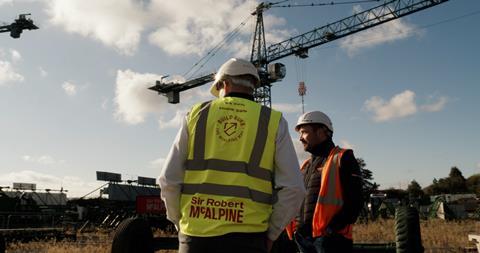The application of data will play a hugely important role in helping the sector achieve its sustainable ambitions, writes Grant Findlay, executive managing director ŌĆō buildings, Sir Robert McAlpine
That construction needs to be at the forefront of efforts to tackle climate change is by now well known.
Directly responsible for 25% of total greenhouse gas emissions, according to the UK Green ║├╔½Ž╚╔·TV Council, it is clearly incumbent on the sector to significantly cut its carbon footprint.
But for all the reported efforts, recent research suggests that carbon emissions have not just rebounded, but now .

Clearly, then, much more needs to be done. And as the clock inexorably ticks, it is becoming increasingly clear to everyone in the sector that we no longer have the luxury of failure.
Crucially, there is no silver bullet and driving sustainability on site has no quick fix. After all, once designs have been set the opportunities to reduce carbon emissions, though still present, are significantly reduced. Once materials have arrived on site and work is underway these opportunities diminish further.
To bridge the gap between the design and construction stages, sustainability needs to be built into the very foundations of a project.
In other words, sustainability needs to be considered and discussed as early in a projectŌĆÖs lifecycle as possible, allowing adjustments to designs, materials and construction methods to be made where needed. And to inform these decisions, the use of data can be immensely helpful.
Using our Embodied Carbon Database
Construction sites are awash with data, but much of it simply isnŌĆÖt used. Indeed, that as much as 95% of the data collected on site is discarded.

Within this ever-growing mass of information, however, lie solutions to driving sustainability, not least when it comes to identifying design solutions and materials with lower embodied carbon.
At Sir Robert McAlpine we not only have a treasure trove of information within our Embodied Carbon Database, but also extensive, practical experience on projects.
At the outset of a project we can bring this data and lived experience, as well as our knowledge of the supply chain, to bear by giving clients an accurate picture of the embodied carbon associated with key elements and materials, factoring in their production, transportation and use on site.
This enables us to advise on potential adjustments to cut embodied carbon: sometimes seemingly small changes that, when aggregated together, make a significant reduction to a projectŌĆÖs embodied carbon.
With materials alone contributing around , identifying design solutions that require less material, and then selecting low-carbon alternatives, can take a significant bite out of emissions.
Elevating this data alongside more traditional considerations such as cost, programme and quality, allows for fully informed decisions to be made.
On one project alone, for instance, we undertook, an in-house embodied carbon assessment and were able to recommend substitutions whilst also rolling out a number of initiatives.

Steel casings were reused as piles; the percentage of cement replacement in concrete was significantly increased without affecting the wider programme; low-carbon aluminium was selected for the window frames; and a one hundred per cent renewable energy tariff was used to supply electricity during construction.
The result of these adjustments, which were all made early and on the basis of the experience and data collected on prior projects, resulted in more than a thousand tonnes of carbon emissions being saved.
Crucially, though, the application of data does not stop here. Rather, the lessons learned on this project will be fed back into the broader data set, allowing them to be deployed on projects across the country and across our operating sectors. The approach is the very embodiment of the idea of standing on the shoulders of giants. Rather than rely on theory, we can rely on lived experience.
Looking to the future
This last point is instructive. If data provides a window to the past, then the most up-to-date possible data is of greater use to a contractor working today than years old information. Our data set, then, is not only growing rapidly, but contains information from projects that have only just completed, meaning it is as accurate, representative and up-to-date as possible.
This cuts to the heart of the issue. Though the collection of data is by no means new, the increasing granularity required for truly accurate assessments has, for years, led to some reluctance amongst contractors to capture it and apply it to projects.
ŌĆ£Although there is some way to go, contractors now have access to sophisticated pools of data on which to base decisions ŌĆō something that will only further improve over time.ŌĆØ
Things are changing, though, partly as a result of increased client demand driving contractors to seek out new routes to sustainability, but also thanks to the maturity of modern data.
Where contractors may once have been presented with limited data sets, the rapid digitisation and increasing maturity of the supply chain has improved both the quantity and quality of available data.
Although there is some way to go, contractors now have access to sophisticated pools of data on which to base decisions ŌĆō something that will only further improve over time.
Just as data will continue to evolve, so too will our approach to applying this data on projects on which weŌĆÖre working or have been brought on as advisers. WeŌĆÖll be exploring how we can apply cutting-edge technologies, AI & ML, to data to create better insights that are even easier to access.
I am immensely proud of the exceptional work Sir Robert McAlpineŌĆÖs sustainability team have done to drive this forward.
They have acted as a flagship for the sector be it through the significant quantities of carbon saved through to the completion of the UKŌĆÖs first commercial development to have been designed in line with the UK Green ║├╔½Ž╚╔·TV CouncilŌĆÖs definition of a net zero building.
And as we look ahead, itŌĆÖs clear that the application of data will play a hugely important role in helping the sector achieve its sustainable ambitions.





















